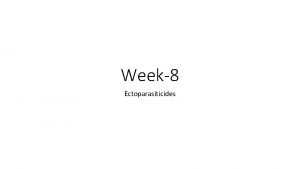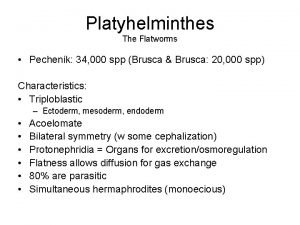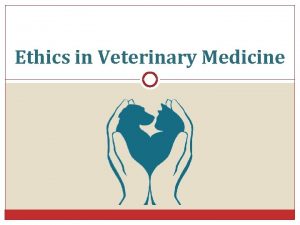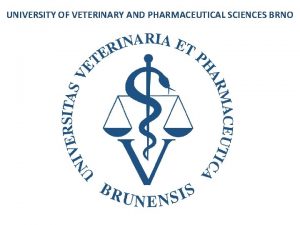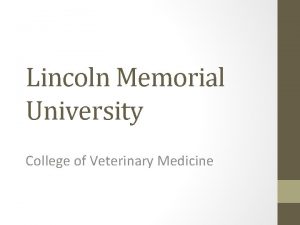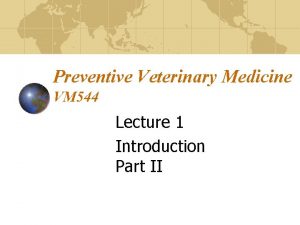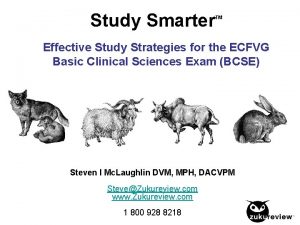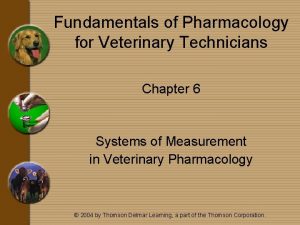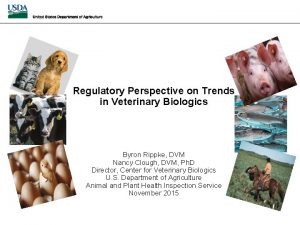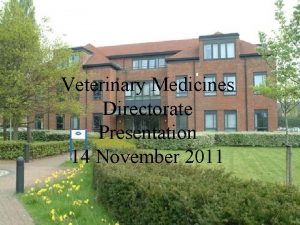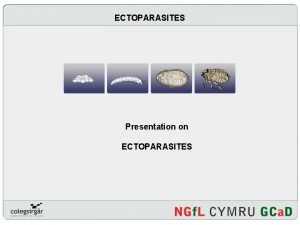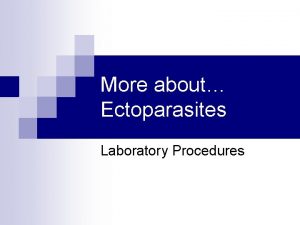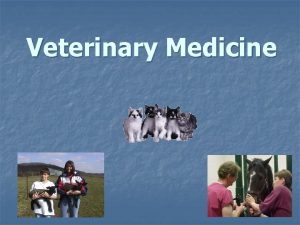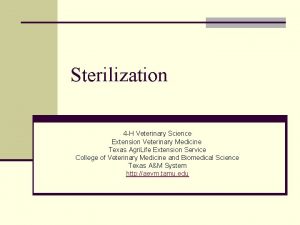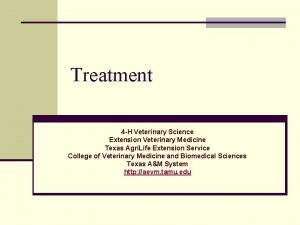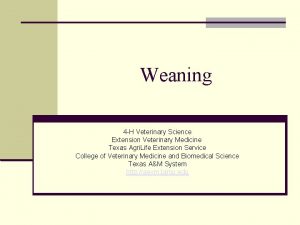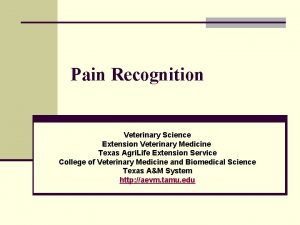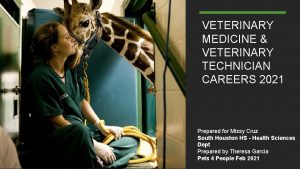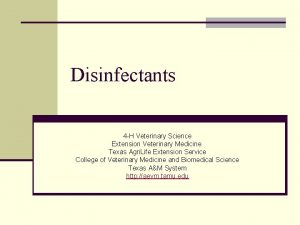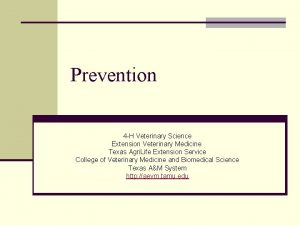Week8 Ectoparasiticides Ectoparasites in veterinary medicine Significant impact















- Slides: 15

Week-8 Ectoparasiticides

Ectoparasites in veterinary medicine • Significant impact on health, well being and productivity • Direct- tissue damage, blood loss • Indirect- vectors of viral, bacterial, helminth, protozol pathogens • Insect ectoparasites- Flies (Diptera), lice (Phthiraptera), felas (Siphonaptera), bugs (Hemiptera) • Arachnid (soft, hard tick+ mite) • Life cycle-important

Some examples of ectoparasite of importance in veterinary medicine • Mites (Acari)- Sarcoptidae, Psoroptidae, Knemidocoptidae, Dermanyssidae, Psorergatidae, Demodicidae, Cheyletiellidae • Ticks (Acari) – Ixodidae- Ixodes, Dermacentor, Haemaphysalis, Rhipicephalus, Boophilus, Hyalomma; Argasidae- Argas, Otobius, Ornithodoros • Adult Flies (Diptera) • Fleas (Siphonaptera) • Lice (Phthiraptera) • Myiasis

Ectoparasiticides: Early compounds, neurotoxins, insect growth regulators Repellents Dessicants Biologic control Vaccination Mode of application Topical/Systemic/Environmental preparation

Control of insect vectors • - by applying ectoparasiticides and insect repellents on the animals – • by using insecticides in and around the premises • - by spraying wider areas • - Use pour-on repellents in animals before their dispatch Biosecurity measures in farms

Insecticides • Ach esterase inhibitors • Pyrethrin synergists • Glucose metab • Organophosphoric compounds • Carbamate • Fluoroacetate • Amine metabolism • Ion channels • DDT and analogues • Pyrethrins • Receptors • BHC, Cyclodien der. , nicotine • Neuromediator like effect • Avermectins • Metabolism • Respiration • Cyanide, carbonmonoxide, rotenone, hydrogen sulphide, dinitrophenols • Microsomal enzyme inhibitors • Chlordimeform • • • Insect growth regulators Protoplasma toxins- Heavy metals, acids Physical toxins- inert powders, heavy metal Alteration of blood clotting- Coumarines Reactive oxygen species- parathion, malathion, parakuate

Organochlorines • BANNED!!!- Wıthdrawn!!! • Environmental persistence- long half lives- endocrine disrupting activity • Chlorinated ethane derivatives- DDT (dichlorodiphenyltrichloroethane), DDE (dichlorodiphenyldichloroethane), and DDD (dicofol, methoxychlor); • Cyclodienes- chlordane, aldrin, dieldrin, hepatochlor, endrin, and toxaphene • Hexachlorocyclohexanes - benzene hexachloride (BHC), lindane (γ-isomer) • Inhibition of sodium conductance - hold sodium channels open, - delayed repolarization of the axonal membrane- vulnerable to repetitive discharge • Cyclodienes- inhibition of γ-aminobutyric acid (GABA)-stimulated Cl– flux and interference with Ca 2+ flux.

Organophosphates and Carbamates • Neutral esters of phosphoric acid • Inhibit the action of acetylcholinesterase (ACh. E) at cholinergic synapses and at muscle endplates (OP= irreversible, carb=reversible) • Coumaphos, diazinon, dichlorvos, malathion, tetrachlorvinphos, trichlorfon, phosmet, and pirimiphos. • Chlorpyrifos, Diazinon and propetamphos • Carbamate – propoxur , carbaryl (withdrawn)

Macrocyclic Lactones • Internal and external parasites in dogs and cats: • selamectin and aprinomectin- semisynthetic avermectins, and moxidectin, a semisynthetic milbemycin. • applied topically • Glutamate-gated chloride channels - increased permeability & continued influx of Cl– - inhibition of nerve activity- cause paralysis • Moxidectin *combo* imidacloprid (Neonicotinoid) • Eprinomectin *combo* fipronil, S-methoprene, praziquantel.

Neonicotinoids- nitroquanidines, neonicotinyls, chloronicotines, and recently as chloronicotinyls • Dinotefuran • Imidacloprid • Nitenpyram. • Agonists on the postsynaptic acetylcholine receptors in insects- inhibition of cholinergic transmission- paralysis and death.

Formamidines • AMITRAZ- control ticks and mites • MAO. Binding octopamine receptors in Acari. • Demodicosis, scabies, ticks • Not approved for cats.

Oxadiazines • Indoxacarb • Bioactivation- pro-insecticide- N-decarbomethoxylated metabolite (more potent) • MAO- blocking the voltage-gated sodium ion channels in insects. • Topical use • Combo- permethrin

Isoxazolines • MAO- arthropod ligand-gated chloride channels. • Afoxolaner and fluralaner • Oral use for flea and tick (insecticide & acaricide)

Insect growth regulators • Synthetic mimics of natural arthropod hormones and enzymes which can inhibit growth and development • Juvenile hormone analogues • • Methoprene Hydroprene Fenoxycarb Pyriproxyfen • Chitin synthesis inhibitors • Diflubenzuron • Lufenuron • cyromazine (a moulting disruptor) • juvenile hormone- involved in the process of moulting between different life-cycle stages (ecdysis) in arthropods. • Induction of elevated levels of juvenile hormone- interferes with reproduction in the arthropod target

Biological control Plant extracts • Azadirachtin is a naturally occurring compound derived from the neem tree (Azadirachta indica)- effective on C. lectularius, P. humanus capitis and D. Gallinae • Lippia multiflora (Bush tea) • Chamomile extract • Teatree oil • Spider venom peptide-neurotoxin-paralysis of sodium and calcium channels • entomopathogenic fungi • Beauvaria bassiana-based compound • Conidia from Metarhizium anisopliae
 Ectoparasiticides veterinary medicines
Ectoparasiticides veterinary medicines James brusca
James brusca Ethical issues in veterinary medicine
Ethical issues in veterinary medicine Veterinary medicine brno
Veterinary medicine brno Faculty of veterinary medicine cairo university
Faculty of veterinary medicine cairo university Faculty of veterinary medicine - university of tehran
Faculty of veterinary medicine - university of tehran Veterinary medicine
Veterinary medicine Lincoln memorial university college of veterinary medicine
Lincoln memorial university college of veterinary medicine Vm 544
Vm 544 Cairo university faculty of veterinary medicine
Cairo university faculty of veterinary medicine Faculty of veterinary medicine cairo university logo
Faculty of veterinary medicine cairo university logo Nutrition jeopardy
Nutrition jeopardy Bcse sample test
Bcse sample test Fundamentals of pharmacology for veterinary technicians
Fundamentals of pharmacology for veterinary technicians Veterinary biologics market
Veterinary biologics market Veterinary medicines directorate
Veterinary medicines directorate
